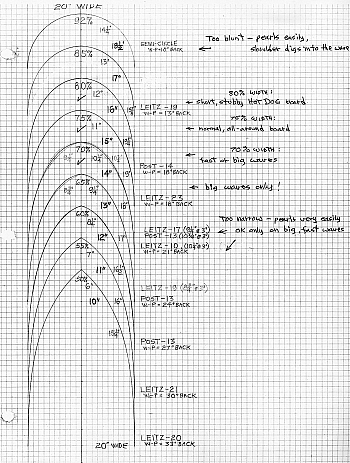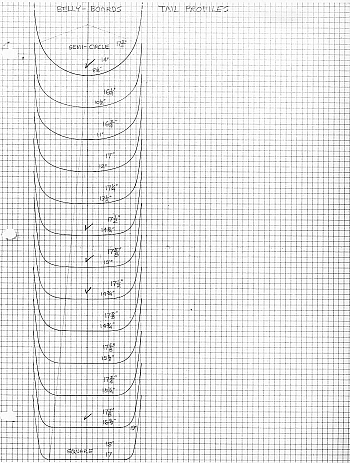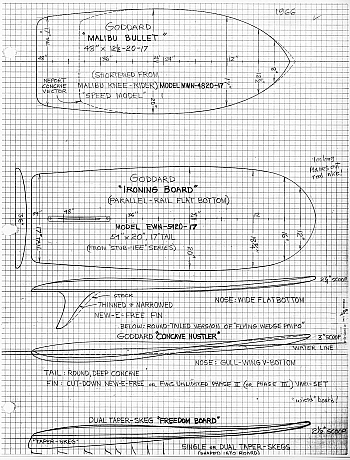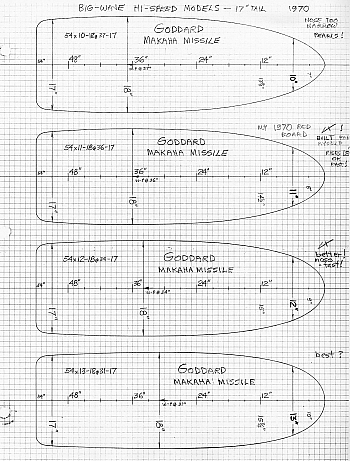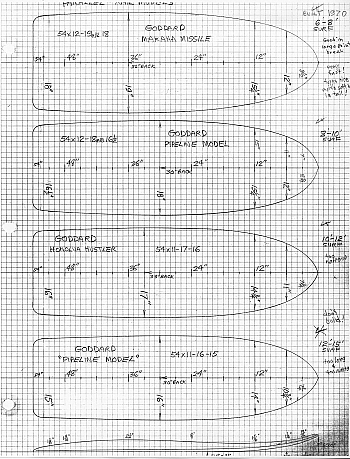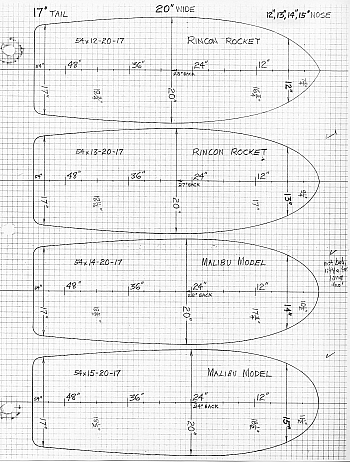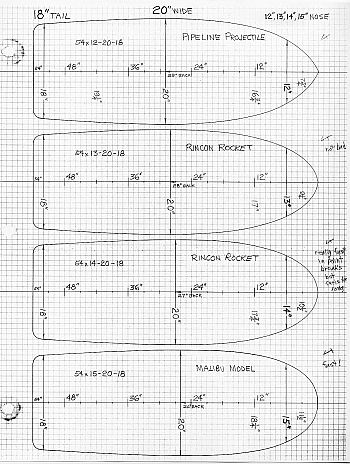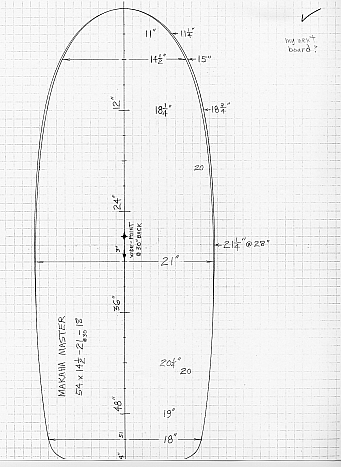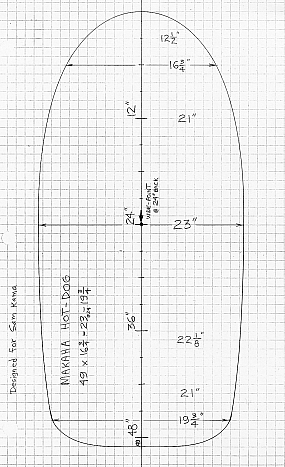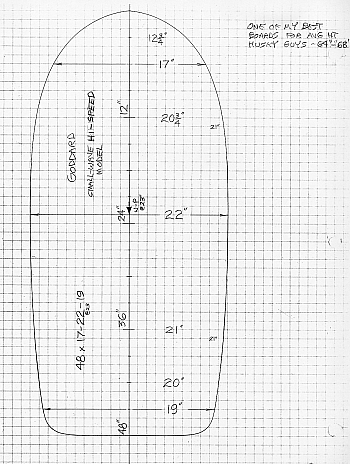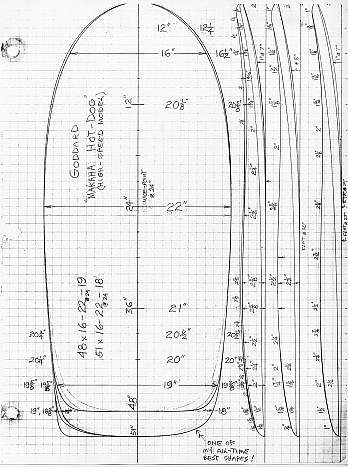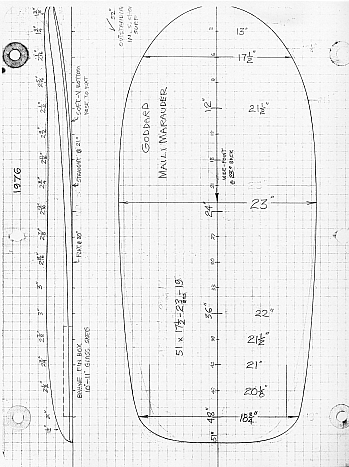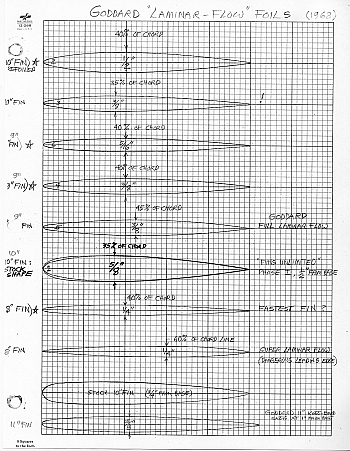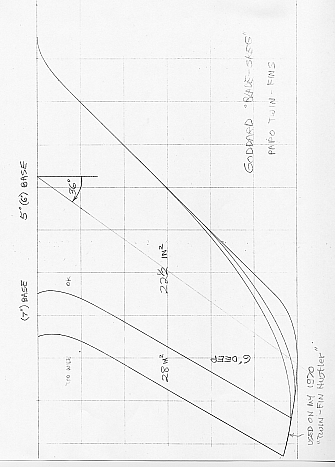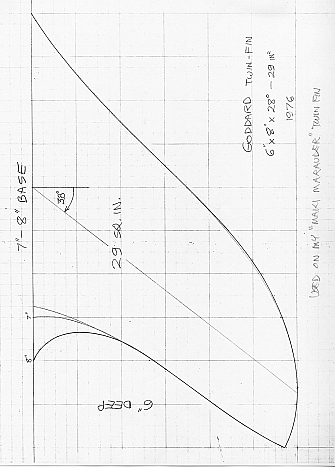Design Sheet Notes:
02 Nose. I designed my first really fast board in
the summer of 1968, which I named "The Spear" because of its narrow
nose (see 10 BDS). But, it pearled too easily when I trimmed forward
for top speed. The nose shape was copied from a surfboard. When
measured 6" back, the nose was only 10 3/4" wide, or 9 1/4" narrower
than the board's widest point. The tail was a super-wide 19", and with
the 1/4" concave in the bottom, was the secret of it's speed. I decided
to draw a series of possible nose shapes, from 50 percent of the
Spear's 20" width, up to a semi-circular round nose, that measured
about 92 percent of the 20" board width. I decided I liked the '70
percent' nose shape best. So, 6" narrower than the board width looked
right. [Note: More information and several photos of the Spear may been found here.]
03 Tails. I also drew a series of possible tail shapes, from a round tail that was 14" wide when measured 3" up from the tail (70 percent of the 20" width), intended for hot dog boards, to a rounded square tail
18" wide, or 90 percent, for the highest possible speed.
Sharply-squared corners are no good for anything but glassy waves, or
if you don't want to make any smooth cutbacks. I decided I liked the
17" wide (85 percent) tail best.
04 BDS. My design exercise sheet for big-wave
boards, with the widest-point set at about midway from the nose to the
tail. I tried 17" to 20" widths, and even built one 15" wide as a
kneeboard, which my friend Steve Hoppe rode on his knees hands off on
his first ride at Makaha on a 15 foot wave. It had a soft vee on the
bottom. The wider-nose, wider-tail versions were the best shapes. They
look like the old Hawaiian 'Alaia' boards!
05 BDS. Having met George Greenough at Rincon in
1965, I thought I'd try designing a board (in 1966) that could be
ridden as a kneeboard OR as a bellyboard. Using narrower tails, I drew
up a series of different board widths, but with the same tail width of
14", 15", or 16". Having had no experience kneeriding, I didn't realize
that these board shapes would be not so good for knee-riding, and the
tails were too narrow for good bellyboards. I did design and build
successful kneeboards by the early- to mid-1970s. Pure Kneeboard
shapes, not intended for bellyriding.
06 BDS (top drawing on page). By 1967, I had
settled on the 54" x 22" overall board size for my favorite point
breaks, Malibu and Rincon. On this page, with the top drawing, I
explored the possible nose and tail widths for my next board. I chose
the extra-wide 19" tail (measured here at 2" up from tail end, because
of the small-radius square tail chosen for high speed). I wanted a nose
width of around 70 to 75 percent of the 22" board width, or somewhere
in the 15.4"-16.5" range. I chose to use the 16" nose (measured at 6"
back), and the resulting nose widths (measured at 3", 6" and 12" back)
were 12"-16"-20", (that nose line is drawn slightly darker). This
became my best nose shape, and when I moved from California to Makaha
in September 1969, that board was my best board for several years,
until I designed the Maili Marauder for Stan Wright in 1972, using the
more rounded square tail corners. Middle and Bottom drawings:
design exercise holding the tail width constant at 18" or 17", and
varying the widths. Some of the wider tail (18") were built in 21" and
22" widths for guys in Hawaii.
08 BDS. These were my first foam and fiberglass
boards that I rode in 1965 after getting experience on the Paipo Nui
and the Ventral Vindicator plywood paipo boards. Floyd Smith kept the
first one he made for me after riding it at Windansea. I got #2. The
Newport Concave Vector was a little too short, and the nose was too
narrow. They came out with a wider round nose version soon after. They
both had twin fins, like my Floyd Smith.
09 BDS. Top: I lengthened the lines of the
Concave Vector, shortened the nose by 1", and got a pretty fast board
shaped like a bullet. It was my first good 48" x 20" board. Bottom:
The "Ironing Board" was too stiff, but OK in waves that didn't allow
cutbacks. Looks kinda like a Hawaiian 'Alaia' board. Only one ever
built.
10 BDS. Bottom board: "The Spear." See my notes for '02-Nose.'
11 BDS. The 'Makaha Missile" series. Holding the
rail shape constant, but varying the board widths from 18" to 21". Only
the top two boards were built. I still have the 18" version. My
'Red`Ferrari' rode Waimea Bay, and big Third Reef Sunset (18') also,
but the board was designed for Makaha Point break, from 12-20 ft. If it
got any bigger, I stayed on the beach and took pictures. Ha! "Gotta
know your limits!" (Dirty Harry).
12 BDS. Design Exercise, Makaha Missile, all 54" x
18", with constant 17" tail, but with varying nose widths from 10" to
13". My red 'Missile' is the second one down from the top, same as the
top one on 11 BDS. See my interview for the design details and
discussion, plus photos. The 11" nose is still a little on the narrow
side. I think a little wider would have been better.
13 BDS. Design Exercise, "Rincon Rocket" series, all
54" x 19", with constant 17" tail, but with varying nose widths from 11
1/2" to 14 1/2". The one at the top of the page never got built (don't
like pointy noses!). Designed for point break waves, with the wide
point near middle of the board. Work well in fast waves!
14 BDS. Design Exercise: The only one ever built was
the one at the top. Worked great at Makaha! My narrower 18" wide
Missile actually worked better on the North Shore in the faster waves.
The 19" version here was better in medium size Makaha Point Break
(around 15 ft or so).
15 BDS. After I rode my first "Spear" for a couple months in
1968, by the time summer ended, I decided the nose should be a little
wider. But, I wondered what the board shapes would look like if I used
the SAME 'Exponential-Curve' rail outline shape (for high speed) as
'The Spear', but moved the wide-point farther forward, making the nose
wider, and letting the tail get narrower. So, I varied the combinations
by 1 inch at a time. The best one proved to be the 3rd one down, the 54
x 13-20-17, which I christened the "Rincon Rocket," because it worked
so well at Rincon Point. The sweet spot seemed to be with a nose 7"
narrower, and the tail 3" narrower than the board.
16 BDS. Continuing the "Rincon Rocket" series of designs, in the
fall of 1968, I drew the 54" x 20" boards, ALL with 17" tails on this
sheet, but varying the nose widths only. The 2nd one from the top is
the original board (same as the 3rd one down on 15 BDS). The 3rd one
down from the top, with the 14" nose, was outstanding in Malibu waves,
so I named it the "Malibu Model" At this point, in the Fall of 1968, I
was building a new board every week! It was beginning to be a problem
finding enough good, clean surf to test my growing stable of new board
designs! I was starting to think about going to Hawaii...
17 BDS. Similar to the series above, all 54" x 20", but this
time with an extra-wide 18" tail (90% of board width), or only 2"
narrower than the widest point. Again, only the nose widths were
changed. By this time (winter of 1968/1969), I was no longer interested
in narrow, pointy or peaked nose shapes, so the top board shape on this
page was not built. The other 3 WERE built, and the bottom two boards
with the wider 14" and 15" noses were ridden in the first south swells
of the new season (May 1969) at Huntington Beach and Malibu. I was
starting to prefer WIDE noses for trimming farther forward to achieve
higher speeds. I started using less kick in the nose, 2 1/2 inches
about this time. The narrower noses usually had 3" kick, but the boards
still pearled too easily.
18 BDS. The board at the top of the figure is my
June, 1970-built "Twin-Fin Hustler," the 51" long by 21" wide version.
The nose is reported in the model designation on the drawing as "18 1/2
inches," but that was the width of the nose measured at 12" back. All
my nose widths since then are given as the width at 6" back, (15" on
the Hustler), while the 'shoulder width is measured at 12" back. To
more completely describe a nose shape, I would include the width at 3"
back, so that the nose shape would therefore be described as 11 1/4" -
15" - 18 1/2" in the case of the Hustler.
Additional Notes on 18 BDS. In frustration, I decided to go to Hawaii at the end of
the summer in 1969 to test my boards. I took 17 boards with me in
September, 1969, and rented an apartment on the beach at Makaha Shores
Condominiums. That was right at the beginning of an El Nino, and the
Sunspot peak. I was about to surf my brains out in some of the best
waves I'd ever ridden! When I went back to California in April, '70, I
built the 54" x 18" "Makaha Missile," and the 51" x 21" "Twin Fin
Hustler,, seen here at the top of this page. Both boards were finished
in June, 1970, but I didn't ride the Missile until a big glassy 10-ft
day at Huntington Beach. Mike Purpus (from Hermosa Beach) and I were
the only two guys out enjoying Pipeline-like barrels until the tide
came up enough to thicken the waves and make them more ridable. There
were no leashes in those days! I still have both the Twin Fin Hustler
and the Makaha Missile.
19 BDS. This was actually the shorter 51" version of
the original 54" 'Maili Marauder'. I thought it would make a decent hot
dog board for the Inside Makaha Rights. It is NOT a Makaha Missile! It
was intended for the 4-8 ft surf in the inside and middle lineups on NW
to North Swells at Makaha, not Point Break (12'+). And I even made a
few of these boards only 48" long, for short but husky local guys (see
23-26 BDS). Too short for my taste, but for a 'pocket rocket', they
worked just fine. #26 BDS was the best one!
20 BDS. This was a 3" longer version of the Twin Fin Hustler
that I seriously considered making for myself, but I never got around
to doing it.
21 BDS. A slightly narrower-nosed, slightly longer version of
the Twin Fin Hustler, but with a redesigned tail for hot-dog waves.
Never built, because I was trying to get away from the narrower nose
shapes.
23 BDS. Very wide, short hot dog board designed for a short, very husky local guy at Makaha. Only one built.
24 BDS. Designed for average height (5' 8") husky local guys and Makaha Inside Rights. Wide tail for speed.
25 BDS. Slighly wider nose, otherwise same as above (Design 24 BDS).
26 BDS. Also designed for short husky guys, but extra wide and
extra thick for the heavier guys, with a more rounded tail design for
hot-dogging and turning ease. This was one of the better shapes.
27 BDS. The 51" x 16-22-18 version seen here is also shown
separately on Design 19 BDS. The 48 x 16-22-19 version is a
continuation of the short, wide board designs for husky local guys of
average height (5' 8").
28 BDS. This was the second, but shorter 51" hot-dog
version of the 1972 "Maili Marauder," made in 1976, for a short but
very husky guy named "Frosty the Snowman," who was a rock musician with
Lee Michaels, living for a while in Makaha. They moved back to San
Francisco before the board was finished, so he never got to ride it. It
turned out to be the best board I ever made for South Shore (Waikiki)
surf, and I rode it until it got stolen in 1985, from a friend of
mine's house in Honolulu. My new yellow board is a wider-tailed version
of this board. Super-fast!
29 BDS. This is my latest version of the 1976 Maili
Marauder 51" version, but not the hot-dog tail version, rather the
Extra-Wide-Tail version that I designed back in 1987, and called the
"Ultra-High Speed Model." Instead of twin fins, I returned to the
single-fin design of the very fast 54" Maili Marauder that I made for
Stan Wright in 1972 (the orange board, seen in the interview photos).
Because of the super-hard rails, thick nose, and the nose-to-tail
concave bottom, I named my new yellow board simply the "Experimental"
model. I now call it "Mellow Yellow" after the famous song. I get a
Natural High when I ride it. It's my magic flying carpet! (I've never
experimented with drugs... didn't need an artificial chemical high,
because surfing, snorkeling, and flying airplanes gave me a John-Denver
style natural high.)
30 BDS. I rode this for a year after after my Paipo Nui got
destroyed on the rocks at Lunada Bay on a big day. It was 36" x 26",
kinda small compared to what most of the guys ride in Hawaii. The
turned-down wings on the tail were intended to give you more edge
control on a steep-wave takeoff, but they didn't help in bumpy waves. I
didn't ride it long enough to learn how to make the best use of its
design features. I sold it in 1966.
31 BDS. The first beautiful outline fin shape I ever saw in late
'68 was the 9" Fins Unlimited 'Phase 1' and the 10" 'Phase II' skegs. I
bought a half dozen of them, and refoiled them to a 'Laminar Flow' foil
shape for much lower drag and high speed. I tested them at Malibu on a
big south swell (12') that summer. My best foil shape was the 2nd one
down from the top, which I used for the 10" skeg on my 54" x 16-22-19
Malibu board, which was built in 1969, while I was still in California.
The 3rd one down was even thinner, with the max thickness at 40% of the
chord, and that is the 9" skeg I put on my 54 x 18" Makaha Missile,
which I still have, to this day! You can see pictures of it in my
interview.
32 Fins. The 7" wide base version is the one on my 1970 Twin Fin
Hustler. Inspired by the shape of the then-new Boeing 747 jumbo jet
vertical fin on the tail. Different, but not seen in nature, so
probably not the best shape for a fin! George Greenough had it right:
look at the fastest fish in the ocean! THAT works!
33 Fins. This is much better: narrower base, narrower tip, about the same rake and area. less drag = faster!
34 Fins. Designed and used on my 2nd Maili Marauder, built in
1977 as a twin fin design. That board was built for "Frosty the
Snowman", rock group drummer with Lee Michaels, but when they returned
to San Francisco, I kept the board and discovered that it was GREAT in
South Shore surf. I only weighed 156 lbs then, so the extra flotation
gave me lots of glide going across dead spots. My new yellow board is
the current iteration of that Marauder series.
35 Fins. Design exercise for twin fin shapes. Narrower base
usually means less drag when turning hard. But the board feels looser,
too. Tail-sliding is more likely.
|
|
